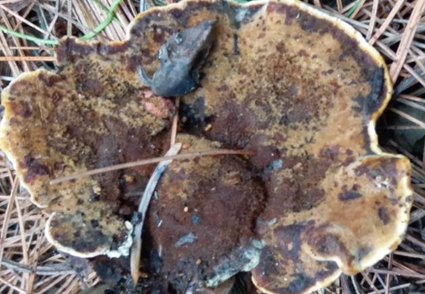Abstract
Onnia pakistanica, a novel species, is described from Khyber Pakhtunkhwa, Pakistan. This species is distinguished from its closest kin, O. tibetica, by its unique rusty orange to clay-buff and fawn pileus, larger (5.0–10.1 × 2.5–9.0 μm) basidiospores, broader and fusoidal cystidioles (11.1–16 × 6.5–8.6 μm) and setae with more or less rounded at the tips and broader at the base. The taxonomic status of this species is supported by molecular phylogenetic analysis using ITS and combined ITS and LSU sequences. The presence of O. pakistanica in Pakistan also marks the first genus record from South Asia, adding to the significance of this discovery.
References
- Afza, R., Ahmad, H., Saqib, Z., Ali, N. & Khan, J. (2016) Phytodiversity of Ayubia National Park Pakistan: Conservation and Management issues. Journal of Biodiversity and Environmental Sciences 8 (2): 327–336.
- Ahmad, S., Iqbal, S.H. & Khalid, A.N. (1997) Fungi of Pakistan. Sultan Ahmad Mycological Society of Pakistan, Department of Botany, University of the Punjab, Quaid-e-Azam Campus, Lahore, pp. 1–248.
- Akhtar, N., Rashid, A., Murad, W. & Bergmeier, E. (2013) Diversity and use of ethnomedicinal plants in the region of Swat, North Pakistan. Journal of Ethnobiology and Ethnomedicine 9 (1): 25. https://doi.org/10.1186/1746-4269-9-25
- Bruns, T.D. (1995) Thoughts on the processes that maintain local species diversity of ectomycorrhizal fungi. In: The significance and regulation of soil biodiversity. Springer Netherlands, pp. 63–73. https://doi.org/10.1007/978-94-011-0479-1_5
- Cubeta, M.A., Echandi, E., Abernethy, T. & Vilgalys, R. (1991) Characterization of anastomosis groups of binucleate Rhizoctonia species using restriction analysis of an amplified ribosomal RNA gene. Phytopathology 81: 1395–1400. https://doi.org/10.1094/Phyto-81-1395
- Dai, Y.C. (2010) Hymenochaetaceae (Basidiomycota) in China. Fungal Diversity 45: 131–343. https://doi.org/10.1007/s13225-010-0066-9
- Gardes, M. & Bruns, T.D. (1993) ITS primers with enhanced specificity of basidiomycetes: application to the identification of mycorrhizae and rusts. Molecular Ecology 2: 113–118. https://doi.org/10.1111/j.1365-294X.1993.tb00005.x
- Ge, C., Cui, Y.N., Jing, P.Y. & Hong, X.Y. (2014) An alternative suite of universal primers for genotyping in multiplex PCR. PloS One 9: e92826. https://doi.org/10.1371/journal.pone.0092826
- Ge, Z.W., Yang, Z.L. & Vellinga, E.C. (2010) The genus Macrolepiota (Agaricaceae, Basidiomycota) in China. Fungal Diversity 45 (1): 81–98. https://doi.org/10.1007/s13225-010-0062-0
- Ge, Z.W., Yang, Z.L., Qasim, T., Nawaz, R., Khalid, A.N. & Vellinga, E.C. (2015) Four new species in Leucoagaricus (Agaricaceae, Basidiomycota) from Asia. Mycologia 107: 1033–1044. https://doi.org/10.3852/14-351
- Gilbertson, R.L. & Ryvarden, L. (1986) North American Polypores. Two volumes. Blindern, Norway: Fungiflora A/S. 1,2.
- Hall, T.A. (1999) BioEdit: a user-friendly biological sequence alignment editor and analysis program for Windows 95/98/NT. Nucleic Acids Symposium Series 41: 95–98.
- Hu, Y., Karunarathna, S.C., Li, H., Galappaththi, M.C., Zhao, C.L., Kakumyan, P. & Mortimer, P.E. (2022) The impact of drying temperature on basidiospore size. Diversity 14 (4): 239. https://doi.org/10.3390/d14040239
- Ji, X.H., He, S.H., Chen, J.J., Si, J., Wu, F., Zhou, L.W., Vlasák, J., Tian, X.M. & Dai, Y.C. (2017) Global diversity and phylogeny of Onnia (Hymenochaetaceae) species on gymnosperms. Mycologia 109 (1): 27–34. https://doi.org/10.1080/00275514.2016.1274619
- Larsson, K.H., Parmasto, E., Fischer, M., Langer, E., Nakasone, K.K. & Redhead, S.A. (2006) Hymenochaetales: a molecular phylogeny for the hymenochaetoid clade. Mycologia 98 (6): 926–936. https://doi.org/10.1080/15572536.2006.11832622
- Munsell, A. (1975) Soil Color Charts. Munsell Color Co, Baltimore, M. D.
- Nei, M. & Kumar, S. (2000) Molecular Evolution and Phylogenetics. Oxford University Press, New York. https://doi.org/10.1093/oso/9780195135848.001.0001
- Niemelä, T. (2005) Polypores, lignicolous fungi. Norrlinia 13: 1–320.
- Ryvarden, L. & Melo, I. (2014) Poroid fungi of Europe. Synopsis Fungorum 31: 1–455.
- Ryvarden, L. (2005) The genus Inonotus. Synopsis Fungorum 21: 1–149.
- Sher, H. & Al-Yemeni, M. (2011) Economically and ecologically important plant communities in high altitude coniferous forest of Malam Jabba, Swat, Pakistan. Saudi Journal of Biological Sciences 18 (1): 53–61. https://doi.org/10.1016/j.sjbs.2010.09.002
- Tamura, K., Stecher, G., Peterson, D., Filipski, A. & Kumar, S. (2013) MEGA6: Molecular Evolutionary Genetics Analysis version 6.0. Molecular Biology and Evolution 30: 2725–2729. https://doi.org/10.1093/molbev/mst197
- Vilgalys, R. & Hester, M. (1990) Rapid genetic identification and mapping of enzymatically amplified ribosomal DNA from several Cryptococcus species. Journal of Bacteriology 172 (8): 4238–4246. https://doi.org/10.1128/jb.172.8.4238-4246.1990
- Wagner, T. & Fischer, M. (2002) Proceedings towards a natural classification of the worldwide taxa Phellinus s.l. and Inonotus s.l., and phylogenetic relationships of allied genera. Mycologia 94: 998–1016. https://doi.org/10.1080/15572536.2003.11833156
- White, T.J., Bruns, T., Lee, S. & Taylor, J. (1990) Amplification and direct sequencing of fungal ribosomal RNA genes for phylogenetics. In: Innis, M.A., Gelfand, D.H., Sninsky, J.J. & White, T.J. (Eds.) A guide to methods and applications. Academic Press, San Diego, pp. 315–322. https://doi.org/10.1016/B978-0-12-372180-8.50042-1
- Zhao, H., Zhou, M., Liu, X.Y., Wu, F. & Dai, Y.C. (2022) Phylogeny, Divergence Time Estimation and Biogeography of the Genus Onnia (Basidiomycota, Hymenochaetaceae). Frontiers in Microbiology 13 (907961): 1–12. https://doi.org/10.3389/fmicb.2022.907961
- Zhou, L.W. (2015) Cylindrosporus flavidus gen. et comb. nov. (Hymenochaetales, Basidiomycota) segregated from Onnia. Phytotaxa 219: 276–282. https://doi.org/10.11646/phytotaxa.219.3.7
- Zhou, L.W., Vlasák, J. & Dai, Y.C. (2016) Taxonomy and phylogeny of Phellinidium (Hymenochaetales, Basidiomycota): a redefinition and the segregation of Coniferiporia gen. nov. for forest pathogens. Fungal Biology 120: 988–1001. https://doi.org/10.1016/j.funbio.2016.04.008
- Zhou, M. & Wu, F. (2018) A new species of Onnia (Hymenochaetales, Basidiomycota) from Vietnam. Phytotaxa 349 (1): 73–78. https://doi.org/10.11646/phytotaxa.349.1.9


